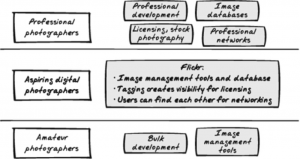As a social networking service, EventHive primarily brings together two distinct groups, event attendees (or potential attendees) and event organisers. The types of events and event organisers that we unite with potential attendees range from local music venues to large sporting tournaments. In this way, EventHive represents a two-sided market, or two-sided network, and EventHive is best referred to as a platform[1]. A platform provides the infrastructure for interactions and transactions between the different sides of the network, attempting to match the demand of the different users[2]. Other examples of online platforms include Flickr.com, eBay.com, and Monster.com.
Within a platform, there are different network effects at play. Different types of network effects include direct network effects, indirect network effects, two-way network effects, and social network effects [3]. The meaning of these terms will be explained in this blog post. Jack will explore the network effects that are at play within our social networking service and consider these effects from both the perspective of the event attendee and event organiser.
Two-Way Network Effects
At its simplest level EventHive facilitates interaction between two types of users, attendees and organisers. In this model, value moves both from left to right and right to left, so there are both costs and rewards – in the broadest sense – found in the two user groups[4]. In addition, the two groups are attracted to each other; event organisers need people to attend their events, and people – generally speaking – want to attend events.
Within a two-sided network, then, there is cross-group dependency; value to any user depends upon the number of users on the opposite side of the network[5]. For example in EventHive, we have greater value to organisers if there are more potential attendees in our network, whilst we have greater value to attendees if there are more event organisers/events represented in our network. The more users on EventHive’s platform the better – there are winners all around.
Direct Network Effects and “Collective User Value”
The cross-group dependency just described can be viewed in terms of direct network effects, where a value of a good or service increases as more people use it. The result of these direct network effects is the creation of what Amy Shuen describes as “collective user value”[6]. In her chapter “Users Create Value,” Shuen considers the collective value of the photo sharing platform Flickr.com. In this section and following in Shuen’s vein, I would like to consider the collectiver user value of EventHive from the perspective of attendees and organisers.
The Attendee Perspective
An event attendee both contributes to, and benefits from, EventHives collective user value in these sorts of ways:
- Being able to discover as many event pages and event organisers.
- Seeing user-generated content about events such as photos videos and other SNS content such as tweets and Instagram posts.
- Attendees contribute to EventHive’s collective value by generating user-generated content and chat opportunities.
- As Shuen points out with regards to Flickr, the more frequent the interaction, the greater the collective value, community and trust, which are elements that equally apply to EventHive[7].
The Organiser Perspective
Equally, an event organiser both contributes to, and benefits from, EventHive’s collective user value in similar ways. Not all direct network effects are positive from the organisers’ perspective and instances of this will be pointed out.
- An event organiser benefits from a large potential-attendee user-base because they represent potential customers.
- An event organiser benefits from user-generated content being shared on eventhive because it promotes their event and increases its apparent popularity. However if user generated content is negative, it will damage an event and event organisers’ reputation.
- The more event organisers and events represented on eventhive, the greater the competition for organisers, which makes attracting new attendees harder and is a negative direct network effect.
Summary
The examples presented here highlight some of the network direct effects that are at play on the EventHive platform. Overall, the more interaction between, and amongs,t the different user groups adds value for EventHive.
Thinking about our social networking service from a network-effect perspective encourages us to think about the collective user value of our platform – what value do the different user groups add to our platform and how can we enhance this? When designing our application, we need to think about what features will help create collective user value; crucially, we need to catalyse and amplify the network effects identified. In turn, we need to consider what revenue streams are available to us on this kind of platform and what revenue models should be adopted.
References
[1] Thomas R. Eisenmann, Geoffrey Parker, and Marshall W. Van Alstyne, “Strategies for Two-Sided Markets,” Harvard Business Review, October 2006. Accessed April 1, 2015.
https://hbr.org/2006/10/strategies-for-two-sided-markets
[2] Ibid.
[3] Amy Shuen, “Users Create Value,” in Web 2.0: A Strategy Guide (Sebastopol, CA: O’Reilly Media, Inc, 2008), 42.
[4] Eisenmann et al, “Strategies for Two-Sided Markets.”
[5] David Easley and Jon Klienberg, “Network Effects,” in Networks, Crowds and Markets: Reasoning about a Highly Connected World (Cambridge, UK: Cambridge University Press, 2010), 509.
[6] Shuen, “Users Create Value,” 2.
[7] Ibid, 7.
[8] Ibid., 15.


No comments yet.